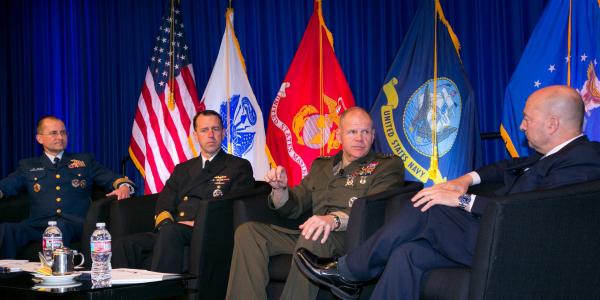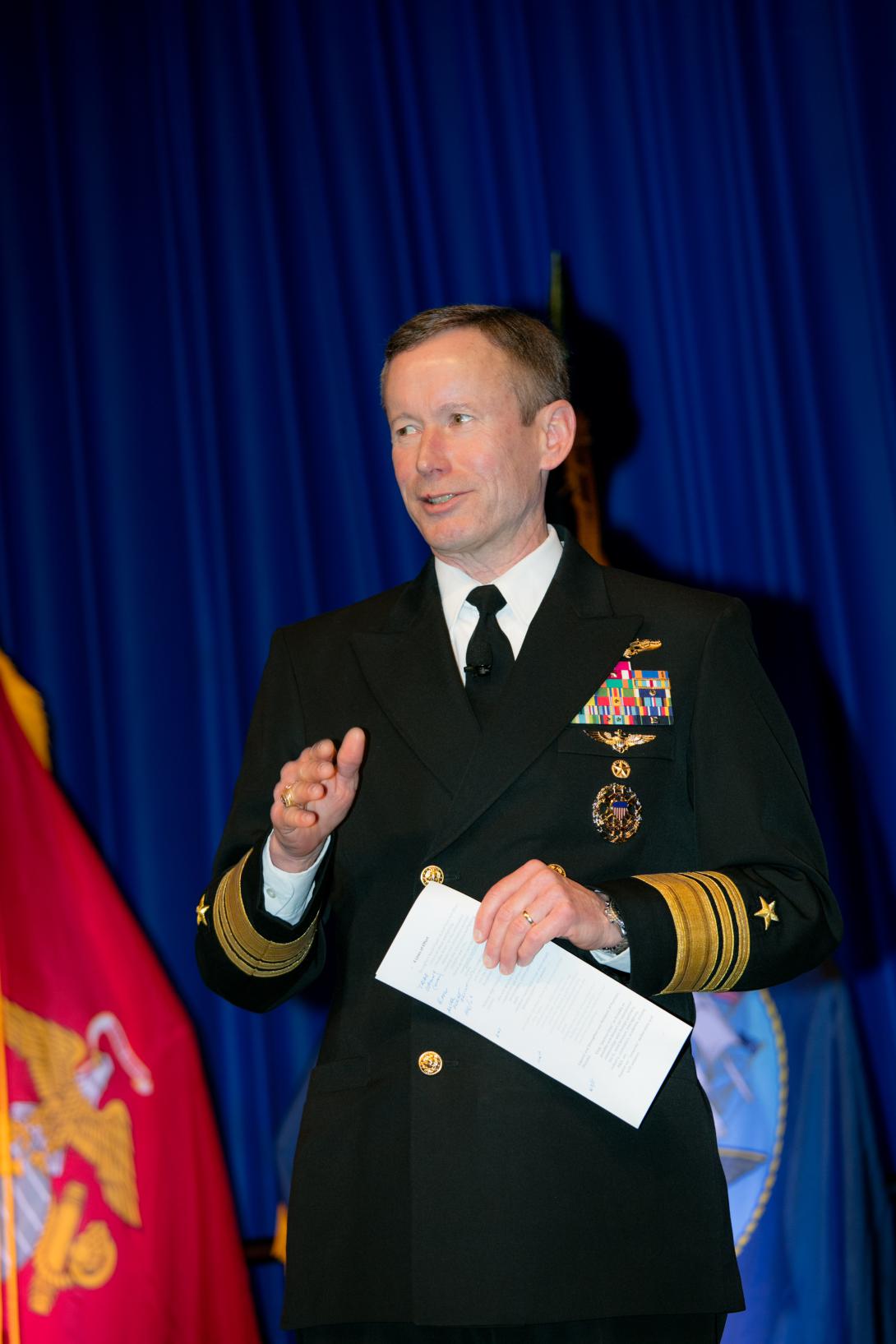Technology Struggles to Keep Pace With Navy Challenges
Possible foes are advancing in capability at the same time that the U.S. Navy, facing shrinking resources, needs to increase its reach. The disturbing trend for the sea services is that they are losing their technological edge just when they are being asked to do more with less. This harsh reality has the Navy and the Marine Corps looking to innovation to help them restore their advantage against increasingly diverse and deadly threats.
How this goal will be achieved was the focus of three days of speakers and panel discussions February 17-19 at West 2016, hosted by AFCEA International and USNI in San Diego. The conference and exposition examined the nature of the challenges facing the sea services with the theme, “How Do We Make the Strategy Work?”
At the top of the threat list is North Korea, and the severity of that challenge was outlined by Adm. James G. Stavridis, USN (Ret.), dean of The Fletcher School of Law and Diplomacy at Tufts University and former NATO supreme allied commander Europe. He called North Korea “the most dangerous country in the world” and added that “they have a young, untested, untried, morbidly obese leader who has nuclear weapons,” referring to Kim Jong Un.
The Islamic State of Iraq and the Levant (ISIL), which the admiral referred to in its shortened form, also poses a new type of threat. Along with its viciousness, ISIL has access to considerable resources. “The Islamic State is different because it raises money like a machine,” Adm. Stavridis said. He also noted that social media is ISIL’s command and control network.
Iran poses a threat because its cash flow is increasing as sanctions lift in the wake of the recent nuclear deal. “As Iran comes off of sanctions, they will think of themselves as an empire,” Adm. Stavridis stated, pointing out Iran’s long imperial history.
Also, Russia does not hold back in its efforts against other nations where it chooses, particularly Ukraine. “Hybrid warfare has been used very effectively in Ukraine, and we haven’t seen the last of it,” the admiral offered.
Above all, cyber is what troubles him the most. “Cyber is where we see the greatest mismatch between level of threat and level of preparation,” Adm. Stavridis said. Virtually every malefactor has operations in cyber, and some nations, such as Russia, are combining cyber with traditional military operations. “Georgia will go down in military history as the first nation to undergo a kinetic attack and a cyber attack at the same time. We have not seen the last of it,” he added.
The Navy is not taking cyber lightly as it embraces information warfare as a warfighting domain. Vice Adm. Ted N. Branch, USN, deputy chief of naval operations (CNO) for information warfare, warned of adversaries reducing or even eliminating the U.S. technological edge that has guaranteed success in military operations for decades. Overreliance on information technologies could be disastrous in a contested environment, so the Navy is preparing its forces to operate under those conditions.
“Victory in the information age will depend on commanders being able to act without all the information being available to them,” he noted.
Lt. Gen. David H. Berger, USMC, commanding general, I Marine Expeditionary Force, said, “We assume the information environment is a contested space.” He added that he worries about threats that target applications and not networks, keeping the networks up so they can wreak more havoc.
The Navy is “well down the path” to make information warfare analogous to the other warfighting domains, Adm. Branch added. That is vital to Navy operations. “If you don’t do information warfare correctly, it doesn’t matter what you do in the other warfighting domains,” he stated.
“Information is a warfare domain, and cyber is as important as the next missile or platform … it’s now [the] commander’s business [and] requires an all-hands effort and a cultural change throughout the Defense Department,” the admiral continued. It is being introduced into nontraditional platforms wherever useful. “If an unmanned system does [intelligence, surveillance and reconnaissance], you should think [information warfare],” he said.
Vice Adm. Jan Tighe, USN, commander, Fleet Cyber Command and commander, 10th Fleet, outlined five long-term goals in Navy cyber operations that involve other service and national assets. Some concentrate on network operations, while others are at the heart of national security activities. The first goal is to operate the network as a warfighting entity, and the second goal involves the development and deployment of cryptology teams. This work is being conducted in concert with the National Security Agency, and it would include tactical Navy signals intelligence capabilities that are forward-deployed.
The third goal is to deliver warfighting effects across several elements, such as cyber and electronic warfare, and it would involve development of a joint force cyber headquarters. Creating a shared cyber situational awareness is the fourth goal, while the fifth goal is building national mission teams that will serve U.S. Cyber Command requirements. These teams would be the Navy’s contribution to domestic cybersecurity and operations, and they would include combatant command mission teams and cyber protection teams.
The Navy makes no secret of its need for innovation. Information technology is at the core of most modernization efforts, including exotic weaponry that would require futuristic command and control. Yet many aspects of acquisition and procurement are stacked against innovation, and the Navy must overcome these or fail in its efforts.
Vice Adm. Peter H. Daly, USN (Ret.), CEO of the U.S. Naval Institute, said, “For years, we had an acquisition system that was ponderous and delivered late. Our technological edge overcame that, but no more.”
Jay M. Cohen, principal, The Chertoff Group and former chief of naval research, described how he was virtually interrogated every time he tried to exercise innovative methods. “Innovation is a contact sport,” he said. “It is not for the weak of heart.”
Innovation can come from many places. CNO Adm. John M. Richardson, USN, spoke of tapping into “the monstrous online gaming environment” for what could add up to millions of ideas. He also wondered about the future environment for collaboration between man and machine.
Adm. Richardson noted that information is a rich area for experimentation, and people often do not realize the potential of capabilities. “Every time we estimate our technology capability, we underestimate it by a factor of two,” he observed. “There are some amazingly sophisticated technologies” that can enable improvements in cyber and other information realms. He added, “Information has to be in the DNA” of U.S. forces, and “using information-sharing policy and technology would allow everyone to fill a role up to their maximum.”
Rear Adm. Lorin Selby, USN, commander, Naval Surface Warfare Center, stated, “We’re playing a 21st-century game with a 20th-century rule book. We’re going to get our clock cleaned.
“The nation that can find and implement innovations quickly will lead this century,” the admiral declared.
For in-depth coverage of West 2016, visit http://url.afcea.org/WestCoverage2016






Comments